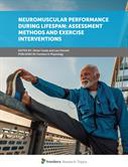Explore

Neuromuscular Performance during Lifespan: Assessment Methods and Exercise Interventions
0 Ungluers have
Faved this Work
Login to Fave
Neuromuscular performance can be regarded as the ability of the neuromuscular system to functionally control and drive movements by an appropriate integration, coordination and use of sensory feedback, reflex activity, central motor drive, muscle recruitment pattern, muscular excitation-contraction coupling and energy availability. This ability, for instance, enables the human organism to maintain stability and posture within the gravitational field in static and dynamic situations, to generate an appropriate amount of force necessary to solve a given motor task successfully or to co-ordinate limb movements in order to protect body structures and to avoid tissue damage. It is widely accepted within the scientific community that a well-developed capacity of the neuromuscular system is highly relevant for fitness and health during the whole lifespan. In early years, the appropriate development of the neuromuscular capacity supports the acquisition of basic movement and motor skills and, thus, contributes to sports competency. In this regard, a high neuromuscular performance may lead children and adolescents into an active and sportive lifestyle. Furthermore, the capacity of the neuromuscular system is fundamental to achieve peak sports performance in late adolescence and young adulthood. In this regard, there is also convincing evidence that injury risk can be reduced by appropriate exercise interventions targeting particularly the neuromuscular system. During later stages of life, a well-trained neuromuscular capacity enables people to stay active and healthy as well as maintaining the ability to fulfil the job requirements. In elderly people, neuromuscular fitness may minimize the risk of falling. During the later stages of life, the capacity of the neuromuscular system remains relevant to deal with the demands of daily life and, thus, to stay mobile and independent as long as possible. Although the relevance of neuromuscular performance is widely recognized, there is a large diversity in assessment methods and potentially efficacious exercise interventions. Whereas the aerobic capacity or muscular strength are very similarly assessed from childhood to older age, for instance, by conducting a VO2 max or one-repetition maximum test, respectively, there is no such uniform assessment method for neuromuscular performance measures. The diversity of assessment methods is at least partly reflected by a large heterogeneity of intervention approaches. This phenomenon might be attributed to an anticipated task-specificity of neuromuscular co-ordination and adaptations. A valid comparison of neuromuscular performance during different stages of the lifespan is therefore difficult.
This book is included in DOAB.
Why read this book? Have your say.
You must be logged in to comment.
Rights Information
Are you the author or publisher of this work? If so, you can claim it as yours by registering as an Unglue.it rights holder.Downloads
This work has been downloaded 151 times via unglue.it ebook links.
- 57 - mobi (CC BY) at Unglue.it.
- 45 - epub (CC BY) at Unglue.it.
- 49 - pdf (CC BY) at Unglue.it.
Keywords
- balance
- Gait
- Mathematics & science
- medicine
- motor co-ordination
- Physiology
- postural control
- Power
- Pre-clinical medicine: basic sciences
- Science: general issues
- sensorimotor
- strength
- thema EDItEUR::M Medicine and Nursing::MF Pre-clinical medicine: basic sciences::MFG Physiology
- thema EDItEUR::P Mathematics and Science::PD Science: general issues
Links
DOI: 10.3389/978-2-88963-277-0Editions

